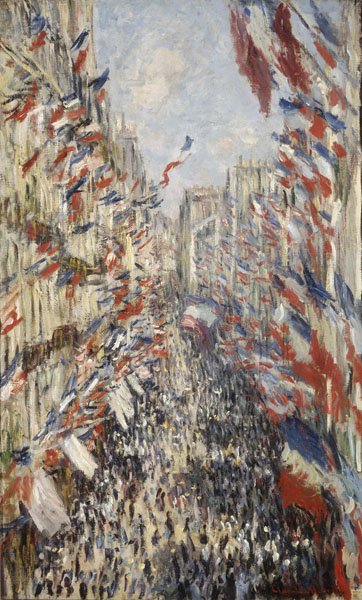Fr : version française / En: english version
mheu, Historical Museum of the Urban Environment
Rue Saint Denis in Paris, Festival of June 30, 1878
Claude Monet

1878
81cm × 50cm
oil on canvas
Paris, Musée d'Orsay
© RMN (Musée d'Orsay) / Hervé Lewandowski
View this work in the exhibition The Street
The work
Monet produced two nearly identical paintings on the same theme: the festival of June 30, 1878 celebrating the end of the Universal Exhibition. One shows Rue Saint Denis, the other Rue Montorgueil, both seen from a high-angle viewpoint on a balcony, both bedecked in a sea of red, white and blue flags. Monet's impressionist style skillfully captured the movement of the joyful crowd and the rippling of the flags in the wind. The two tricolor paintings also embody his belief in the Republic (though the year was only 1878) and in democracy.
The effect is like a nursery rhyme, featuring three key notes, and it is perhaps this musical aspect that appealed to the composer from Ambert, Emmanuel Chabrier, who bought the picture. Manet painted a piece on the same theme, though filled with melancholy, entitled Rue Mosnier aux Drapeaux, which portrays a nearly empty street seen through the eyes of a curious onlooker. Monet's approach was more "aloof": he did not partake in the crowd's jubilation but instead adopted a more remote yet dominant viewpoint.
The artist
Claude Monet was born in Paris on November 14, 1840, but stayed only five years in the French capital. His parents moved to Le Havre in 1845, where they sold colonial wares. As a teenager, Monet showed his caricatures in local art shops, which led to a meeting with Eugène Boudin, with whom he began painting landscapes. Monet refused to attend Le Havre school of fine arts and set off to study at the Académie Suisse in Paris, where he met Pissarro and Cézanne. Returning to Le Havre after completing his national service, he completed his studies with Boudin and the Dutch artist Jongkind, before returning to the capital and the studio of Charles Gleyre, where he met Sisley, Bazille and Renoir.
In the 1860s, Monet and his friends often met Manet and Zola at Café Guerbois, had their work refused at every Salon, sought new inspiration around Paris and subsisted in extreme poverty. In 1869, Monet and Renoir did the first paintings in Bougival, featuring the visible brush strokes that prefigured impressionism. The following year, Monet married Camille, his model, with whom he already had a son, Jean, born in 1867. In 1874, weary of official rebuttals, the young painters organized their own exhibition in the studio of the photographer Nadar, where Monet exhibited Impression, Sunrise, the picture that spawned the satirical criticism that inadvertently gave the movement its name.
The 1870s were much like the previous decade: Monet produced wonderful paintings yet continued to exist on the poverty line. He was now living outside Paris (in Argenteuil and Vetheuil), where life was more affordable. He traveled to London in search of Turner, where he met Whistler, whom he befriended. Camille died in 1979 and Monet moved to Poissy, then to Giverny in 1883, where he lived until his death on December 5, 1926. He began to taste success in Giverny in the late 1880s (largely thanks to his friend the writer and critic Octave Mirbeau), bought the property in 1890, remarried a woman named Alice in 1892, and began to cultivate his garden, with its large willow trees and pond covered in water lilies, which he continued to paint until his final days.